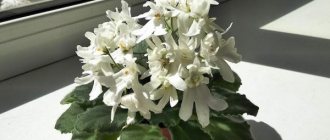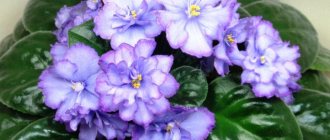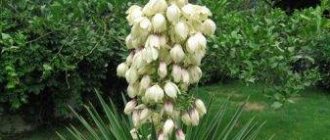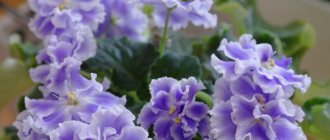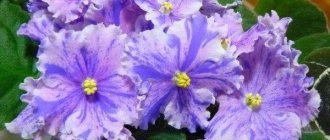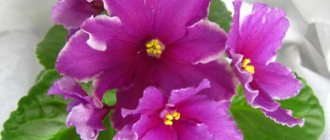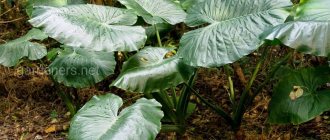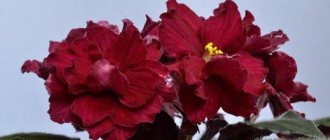Violet is a plant loved by many. The unpretentious, expressive Saintpaulia can be found among flower growers in offices, at home, in the country, or even in the car. Violet is also used to decorate interiors and as an elegant design solution. One of the many varieties of violets that attracts with its brightness is Bullfight.
Violet is indispensable for creative interior designers. Thanks to the refined beauty of its flowers and natural splendor, this plant is used in decoration in the Baroque, Rococo and many other styles. Saintpaulia is also extremely popular among fashionable couturiers, who use fresh young flowers of various shades to decorate their newfangled clothes.
Violet on a background of gray canvas
Description of the variety
Violet wedding bouquet - flower description
This violet is easy to distinguish among other similar varieties. Belongs to large-flowered varieties. A distinctive feature of the plant is the presence of a constantly blooming magnificent head of red flowers. The flowers are star-shaped, double or semi-double.
The Bullfight violet blooms all year round. First, 3 peduncles with two buds appear. As soon as they bloom, new 3 buds grow. The result is a spectacular bouquet. If you properly care for the plant and, which is very important, feed it regularly, the flower rosette will reach 30 cm in diameter.
The leaves are large, somewhat elongated, bright green. Their edges are somewhat wavy.
From this variety comes the violet Bullfight gold (that is, “golden”). The leaves of the Violet bullfight gold in the center of the rosette are white or with a lemon tint. The lower leaves are bright and green. Cherry flowers together with these leaves look very beautiful and elegant.
EK Bullfight is similar to the varieties of violets Corrida, Blackberry EK-Magaraj. The bullfighting violet, unlike the bullfighting violet, has large semi-double white flowers.
Flowering period
With good care, violets bloom almost all year round: up to 8-9 months. The flowering of Saintpaulia is not related to the time of year, but mainly depends on the growing conditions created for it. The most abundant flowering is observed in spring and summer. It is difficult to predict exactly when a plant will bloom. Violets grown from leaves can bloom in 8 months, some take a whole year, sometimes you have to wait a year and a half. There are varieties ( Sorano selection ) that bloom all year round:
- Emerald Pink with many flowers in shades of light coral pink, surrounded by a border of light green.
- Anastasia, distinguished by light flowers with sky-blue watercolor petals, marked with dark stains, with corrugated edges.
Features of care
Description of the flower variety violet Duchess Lux
In order for the plant to please the eye with beautiful flowers and not get sick, you need to strictly and carefully follow the care recommendations.
Temperature
The flower feels excellent at an ambient temperature of 18 to 25 degrees. Violet is afraid of cold and drafts. Higher temperatures also have a detrimental effect on it.
Lighting
It is recommended to grow violets on a flower rack using artificial lighting. It should be placed on windows facing north, northeast or northwest.
Violet loves bright light
Important! Direct rays of the sun have a detrimental effect on violets. Despite this, you need to keep 12 to 14 hours of daylight. The lack of light is compensated by a lamp with a yellow spectrum (not incandescent). Moreover, once every 3 days the plant turns the opposite side to the light source.
Watering
The plant needs sufficient moisture to grow and bloom. Water the plant when the soil in the pot is about a third dry. The violet should be watered with settled water at room temperature. The stream is directed to the root. You should not allow water to get on the leaves - they not only change color, but also begin to rot.
There are several methods of watering:
- Water is poured into the pot using a watering can with a long spout.
- The pot is placed in 2/3 water for about half an hour, so that the moisture is absorbed into the soil through the drainage.
- A wick is pulled through the drainage hole. Its end is placed in a container of water under the pot.
Spraying
The plant cannot be sprayed. Spraying water is allowed at a distance of about 2 meters from the plant.
Humidity
The air humidity in the room where the “Bullfight” violet is located should be no less than 50% and no more than 65%. Air humidity can be increased by placing containers filled with water near the plant.
Priming
You need to use a purchased soil mixture for violets. You can prepare it yourself by mixing peat, leaf, turf and coniferous soil, and sand in equal proportions. A small amount of perlite or vermiculite is used to loosen the soil.
Soil for violets
Feeding
Fertilizers are applied every 2 weeks. Nitrogen fertilizers are necessary during the formation of the rosette and the active growth of leaves.
When buds form, or when a plant blooms, it needs phosphorus and potassium, as well as trace elements. Fertilizing is carried out with mineral mixtures. The recommended concentration of fertilizer should be reduced by approximately 2 times.
Note! Fertilizing is carried out only for healthy plants. After transplantation, fertilizers are not applied for 2 months. The same restriction applies if the violet has been affected by disease.
During the flowering period
During the flowering period, violets need regular watering. The gardener's task is to maintain a normal level of soil moisture. It should not be dry and at the same time overly flooded with water.
In addition, the plant regularly needs phosphorus fertilizers so that the flowers are powerful and rich in color. The plant is fed strictly according to the instructions for using the fertilizer.
Optimal conditions
Saintpaulia of this variety is usually kept in artificial light, as well as on windows located in the north, northeast or northwest. This variety does not tolerate direct sunlight, but at the same time it requires illumination for 12-15 hours a day, so the deficiency of natural insolation must be compensated for with special phytolamps or yellow spectrum fluorescent bulbs. If Saintpaulia is placed on a window, then it must be turned with different sides towards the window 2-3 times a day. Thanks to this, the rosette is formed symmetrical and neat.
The optimal indoor air temperature is 18-25 degrees. The flower does not tolerate frequent drafts and low temperatures. The humidity level should be maintained at 50-60%, but it is not recommended to increase it artificially by spraying the plant. It is better to turn on a humidifier or at least an indoor fountain for several hours a day. If neither one nor the other is in the house, you can spray water from a spray bottle from time to time at a distance of 1.5-2 meters from the flower.
When and how does it bloom
Violet Black Pearl - description of a home flower
The plant is distinguished by some peculiarities in flowering.
Color and design of flowers
Interesting. The shade of the petals changes depending on the lighting: in the sun they are scarlet, in cloudy weather they are ruby or cherry.
Violets of this variety have practically no colors that would differ significantly from the red color scheme.
Saintpaulia flower
Flower shape and size
The size of the flowers is large - up to 8 cm. The flowers are star-shaped, double.
Flowering period
A distinctive feature of this variety of violet is that it blooms throughout the year. The rosette constantly throws out new flower stalks, on which beautiful and lush flowers grow.
Violet, description and photo EK-Boy Bykov (E. Korshunova)
Violets from breeders of the CIS countries – “B” (EK-2).
EK- Bullfight (E. Korshunova).
EK-Bullfight, EK-Boi Bykov (E. Korshunova).
Huge (up to 8 cm) semi-double and double notched blood-red stars. The sport EK-Boy Bykov Gold (E. Korshunova) is registered from him.
Bright green elongated foliage. Standard. Since childhood it has grown compact. The rosette is dense and completely flat, although the leaves themselves are the size of your palm. There are few leaves. I don’t like the rosette of an adult plant - it’s too big, the leaves are light, and it tends to compact the center.
The flowers are very large (6-8 cm) and very dark, the petals are dense, the color is rich. Still, it is not red, closer to cherry blossom. In different lighting, the flower plays with different colors. The color changes depending on the lighting; in the sun it is redder and glows scarlet than in diffused light. On a cloudy day it is dim. Plants from different sources vary greatly.
The huge flowers are not lost in the cap, they cover the entire middle of the rosette. Each subsequent flower does not become smaller, as is observed in some varieties, all are approximately the same size. Three huge flowers bloom, then again three flowers. While the first three flowers were blooming, three more peduncles grew, followed by three more in a checkerboard pattern, so three buds in a row bloom for the third time - this is a feature of the variety. So it blooms without interruption. Again 3 peduncles of 1-2 flowers each. For the second month now, the flowers have not faded, but new flower stalks are growing and the flowers are opening.
But he doesn’t want to grow a hat. The beauty of his flowers is not in quantity, but in quality. Even 5-6 flowers create the effect of a bouquet. Especially on the windowsill.
In the first flowering there is only a hint of doubleness. Flowers do not want to become double. In mine, too, the first 1-2 flowers are not double, but the next ones begin to double. It happens that the first two or three flowers that open are not double, but the rest are double. And so in every flowering. Or all terry at once. I have bloomed 4 times and 2 times double, 2 times not, never had a bouquet. All the beauty of this variety can be seen only after 3-4 flowerings. It grows a neat, symmetrical, but not small rosette, and then the flowers show their true size. The flowers are long-lasting and do not lose color over time.
There are few flowers, one at a time on powerful peduncles. There is only one flower on each peduncle, so there are almost always few flowers. Peduncles are strong and hold flowers. The peduncles are not tall and do not fall apart throughout the rosette, but rather lay down on their own under the weight of the flower.
Loves frequent feeding with fertilizers. The lower leaves turn yellow all the time and quickly fall off - the flowering and 2 rows of leaves must be removed.
Do you know that…?
Classification by flower size. •— Small-flowered – less than 2 cm in diameter; •— Medium-flowered – from 3 to 4.5 cm; •— Large-flowered – 4.5–6.5 cm; •— Huge – more than 6.5 and up to 10 cm! The size of the leaf and rosette influences the perception of the size of a flower: against the background of large leaves, even a large flower can get “lost.” If the size of the flower is comparable to or larger than the leaf, such a flower appears large.
Bullfighting Gold is a fixed sport from the EK-Bullfighting variety. Large (up to 8 cm) semi-double dark blood-red stars. A beautiful exhibition variegated foliage, the center of the rosette is completely lemon-white, sometimes there is an almost white rosette. The leaves are white only in the middle, and the lower ones are green. Huge red flowers on lemon foliage. Bright contrast of flower and leaves.
The strong lack of chlorophyll of the leaves does not at all prevent this variety from growing and reproducing. He just does it slower than a regular Bullfight. Crown variegation appears from a very early age and does not disappear with changes in temperature and lighting.
Bullfighting or tauromachy (from the Greek bull and fight) is a competition between a person and a bull (sometimes this concept may include a fight between bulls or baiting a bull). Bullfighting is practiced only in a few countries, the most famous of which is the Spanish variety, bullfighting.
Before you buy the violets listed below, carefully read the forums about their behavior on the windowsill. Many of them are very beautiful flowers. However, these can be large rosettes with large and fragile leaves, with leaves rising up or hugging the pot, forming many stepsons that interfere with the formation of a neat rosette, pulling the stem up and growing into a Christmas tree, bending the trunk, rare flowering with long breaks, fallen flowers or they last little and quickly wither, very long and recumbent peduncles, the color of the flower fades quickly, they do not like bright lighting on the windowsill, they are afraid of the slightest drying out or waterlogging, a large percentage of them go into sports or darken the flower.
How to propagate violets
There are several ways to propagate violets: by seeds, leaves, or daughter rosettes.
Germination of seeds
Growing this violet using seeds has many complex steps and is therefore only accessible to breeders.
Rooting cuttings
The leaf must be cut from the second row of the rosette. The cut is made with a sharp knife along an oblique line approximately 3 cm from the base of the leaf plate. The cutting is placed in a small container with water or a mixture of soil and sand. After the roots appear, the cuttings need to be planted in a pot with soil. The babies will appear in about a month.
To obtain daughter rosettes, they need to be cut and rooted. Small daughter rosettes appear on the stump remaining after cutting the plant. When they have increased by about 3 cm, they are separated from the outlet and then transplanted into small pots. They need to be covered with a bag on top. The cover is removed when new leaves appear on the rosette. When they grow to about 4 cm, they are removed.
Rooting and germination of cuttings
Other options
There is a way to propagate violets using leaves. The sequence of actions will be as follows:
- cut a leaf;
- place it about 2 cm into the soil, lightly squeeze the soil around it;
- cover with a glass jar and pour over.
Reproduction
Saintpaulia "Bullfight" is propagated by seeds, stepsons or cuttings. The first method is considered quite troublesome and time-consuming, so it is mainly used by breeders to develop new varieties. At home, other vegetative methods are available to gardeners. The most common is cuttings.
To propagate violets, use a cutting taken from the second row of a rosette of a full-fledged flower. To do this, make a neat oblique cut 3-5 cm from the base of the leaf plate with pruning shears. The sprout is placed in a vessel with water at room temperature. To prevent root rotting, the substrate is slightly colored with a solution of methylene blue or an activated carbon tablet is added. As soon as a root of 1.5-2 cm in size appears, you can transplant the plant into the ground. As a rule, babies appear after a month.
The second option for propagating Saintpaulia “Bullfight” is through rosettes. It should be noted that this type of violet practically does not produce stepsons, so their appearance must be stimulated. For this purpose, carefully pinch the dew point at the outlet. At this moment, the plant’s “instinct of self-preservation” turns on, it begins to intensively produce new rosettes, and daughter rosettes are already formed from them. When the length of the stepsons reaches 3 cm, they can be separated from the small flower and planted in separate containers.
At first, the young plant must be kept in greenhouse conditions. To do this, cover the stepsons with a plastic cup or bag and wait for the young leaves to appear. Then the insulating “cap” is removed.
You can watch a review of the Bullfight violet in the video below.
Replanting after purchase
The violet is replanted every year, around the beginning of March. This frequency is due to the fact that prolonged flowering leads to soil depletion. The plant needs fresh substrate with nutrients. The pot should be wide and low, because the root of the plant occupies the surface layer of soil. Its other layers will acidify. The diameter of the pot should be no more than 12 cm.
Important! Violets will not bloom in bulky containers.
Drainage in the form of small pebbles, gravel, and foam is placed at the bottom of the pot. It will remove excess moisture and prevent rotting.
Reminder for a newbie!
Uzambara (Uzumbar) violet is a plant of the Gesneriaceae family, growing in the natural environment of tropical and subtropical regions of Asia, Africa, Eastern Australia, South America and the Indian Ocean islands.
Saintpaulia is a plant named after the Saint-Paul father and son, who brought a plant unknown to Europeans from the Uzambara district (modern Tanzania) in the 19th century, presented for the first time at the international flower exhibition in Ghent in 1893.
Indoor violet has been one of the most popular plants in indoor floriculture since 1927. By 1949, more than 100 varieties had been bred, and today their number exceeds several thousand.
Rooting
- possibly in water, in substrate, moss.
Priming
- purchased soil or a mixture of leaf, coniferous, turf and peat soil in a ratio of 3:1:2:1 with the addition of raising agents (perlite, vermiculite, river sand, crushed sphagnum moss.
Lighting - it is best to place flower pots on western or eastern windows. To ensure that the plant is evenly illuminated from all sides, the pots are periodically rotated. In winter, when daylight hours decrease, you can use artificial lighting - fluorescent lamps.
Caring is a real art and serious painstaking work at the same time, including watering, fertilizing, and creating a favorable humid climate. Water Saintpaulias as the soil dries. The soil must be moistened regularly, but excess moisture should not stagnate in the roots. When watering, you must ensure that water does not get on the leaves. You cannot water the Uzambara violet with cold water. Fertilizing is done with complex mineral fertilizer once every two weeks. Saintpaulia reacts negatively to a lack of nitrogen in the soil. Optimal air humidity is approximately 50%, temperature is 20-22 ° C, without sudden fluctuations and drafts. The leaves of the plant should not touch the window glass. Removal of faded flowers and damaged leaves is carried out regularly.
Reproduction - planting a leaf cutting, part of a leaf, or a daughter rosette. The most popular method is rooting leaf cuttings. The formation of roots and the development of children lasts 4-8 weeks.
Pests are one of the gardener's problems. There are many different types of pests and it is very difficult to classify them. Among Saintpaulia pests, several groups can be distinguished: mites (spider mites, flat mites, transparent mites, etc.), insects (aphids, thrips, springtails, poduras, scale insects, whiteflies, scale insects, etc.), worms (nematodes).
Diseases - distinguish between infectious (gray rot, powdery mildew) and non-infectious diseases (rotting of the stem and root, wilting of the lower leaves, yellowing, leaf spotting, incomplete opening and premature drying, falling of flowers) of plants. The causative agents of infectious diseases are bacteria, fungi, and viruses. To prevent infectious diseases, you should strictly observe the regimes of watering, temperature, humidity, and lighting. Non-communicable diseases usually arise due to poor agricultural practices. They may appear in one instance and not spread to others.
People who communicate with us are: Moscow, St. Petersburg, Novgorod, Omsk, Krasnodar, Yekaterinburg, Voronezh, Kazan, Samara, Togliatti, Novokuznetsk, Astrakhan, Volgograd, Vladimir, Bryansk, Izhevsk, Irkutsk, Ufa and rep., Chelyabinsk, Chita, Yaroslavl , Kaluga, Sochi, Orel, Orenburg, Penza, Perm, Rostov, Ryazan, Saratov, Smolensk, Syktyvkar, Tver, Novosibirsk, Tula, Tyumen, Krasnoyarsk, Ulan-Ude, etc.
CIS countries, Belarus, Ukraine, USA, Germany, Latvia, Moldova, Kazakhstan, Russia.
Forum | Let's consider everything: reproduction and care at home, master classes. Let's discuss home (indoor) types - help, advice: how to do it right, what's best.
“Violets without borders” – 2011-2020
Possible problems
Violet diseases develop if it suffers from a lack of sunlight or, conversely, is exposed to strong insolation, watered with cold water, or located in a room with low temperature and high humidity. As soon as the first signs of damage appear, you should remove all diseased leaves and transplant the plant into a new pot with new soil. The leaves are treated with an appropriate preparation with a fungicidal effect.
Diseases
The most common diseases of the Bullfight violet are late blight, gray or powdery mildew, fusarium, and gray rot. All of them develop due to excessive watering or non-compliance with maintenance conditions.
It is possible to save a violet only at the early stages of the development of the disease. The affected parts of the plant are thrown away, healthy leaves are treated with drugs.
Powdery mildew
Pests
The following pests pose the greatest danger to the plant:
- aphid;
- thrips;
- mites;
- nematodes;
- fungus mosquitoes;
- Scale insects.
If the leaves of the plant are affected by these pests, you need to wash them with a soapy solution, then treat them with the insecticidal solution of Alatar, Actellik, Furanon, etc.
Other problems
The variety is somewhat capricious. Sometimes flowering is unstable, double petals appear after the third flowering.
It happens that the leaves of the bottom row begin to turn yellow prematurely. This phenomenon is independent of ambient temperature. Yellowing of the leaves does not mean that the plant is affected by any disease. The lower leaves may constantly turn yellow and fall off, and new ones grow in their place.
The “Bullfight” violet is an excellent decoration for any room. The undoubted advantage of the plant is its ability to bloom all year round. The plant requires care, for which it gives beautiful flowers in gratitude.
Growing conditions
In order for a flower to develop well, it is necessary to take into account its wishes regarding its cultivation, that is, fulfill some requirements for caring for it:
- The container for violets is not high, but wide, with a volume of no more than a liter.
- Replanting is done annually in the spring with inspection of the plant’s root system and replacement of the soil.
- Where the violet lives there should be no cold drafts.
- The temperature regime for normal violet growth should be within 18-25 degrees Celsius.
Few people know that the familiar word “violet” is the common name for Saintpaulia. Plants are decorative, so they often serve as decoration for home and office spaces. One of the most interesting varieties of this indoor flower is “Bullfight”. Let's look at the intricacies of growing this variety.
The variety “EK-Bullfight Gold” stands out among others. It is an indoor plant with fairly large double star-shaped flowers of a rich “bloody” color. Depending on the nature of the lighting in the room, violet delights the eye with the most incredible shades. In bright light the flowers become bright scarlet, and in cloudy weather they turn brown and ruby.
A distinctive feature of this variety is year-round flowering. First, the rosette produces two or three low peduncles with a pair of buds on each. As soon as they begin to open, three more are formed. The result is a huge bouquet with flowers up to 8 cm in diameter.
"Bullfight" is a capricious plant. Most flower growers note the instability of its flowering, and doubleness often appears only on the third casting of peduncles, although there are cases when the rosette produced a double flower the first time. In addition, facts of alternation in the quality of the flowers themselves between individual blooms are recorded.
Another unpleasant feature of this Saintpaulia is the frequent yellowing of the leaves in the bottom row. Often the leaf plates located at the bottom of the rosette turn yellow and quickly die after the next bud opens. Moreover, this process does not depend in any way on the level of illumination, temperature conditions and irrigation features. This also does not mean that the plant has encountered a disease. That’s just the nature of Saintpaulia Bullfight.
It is recommended to grow the Bullfight violet on a shelf under artificial light, on north, north-east or north-west windows.
Violet variety Bullfight does not like direct sunlight.
The variety does not tolerate direct sunlight, but the plant's daylight hours should be 12-14 rays. It is recommended to compensate for the lack of light using a yellow spectrum fluorescent lamp.
The air temperature for keeping violets is from 18 to 25 degrees. The plant does not tolerate cold and drafts. The humidity in the room where the violet grows should be kept between 50 and 65%. It is impossible to increase the moisture content by spraying the plant itself. It is only permissible to spray water at a distance of 1-2 meters from the violet. Installing open containers of water next to the violet will help increase the humidity level.
